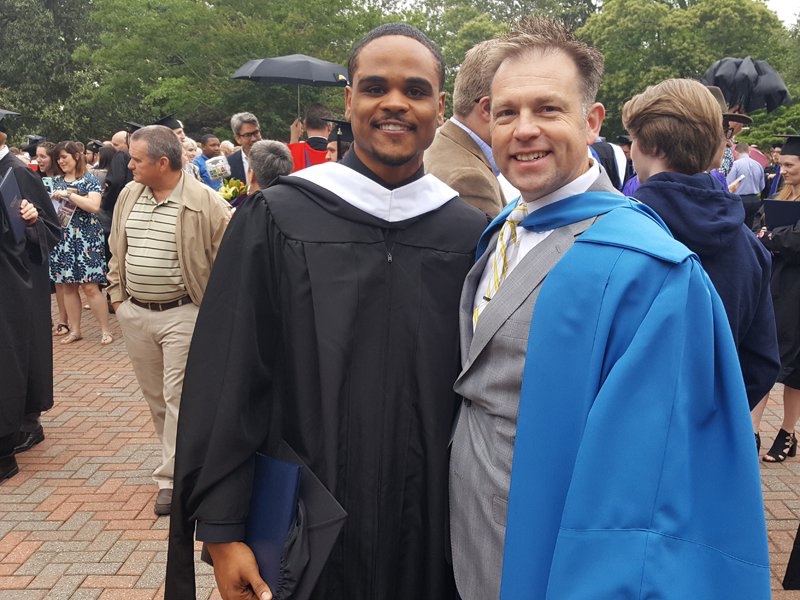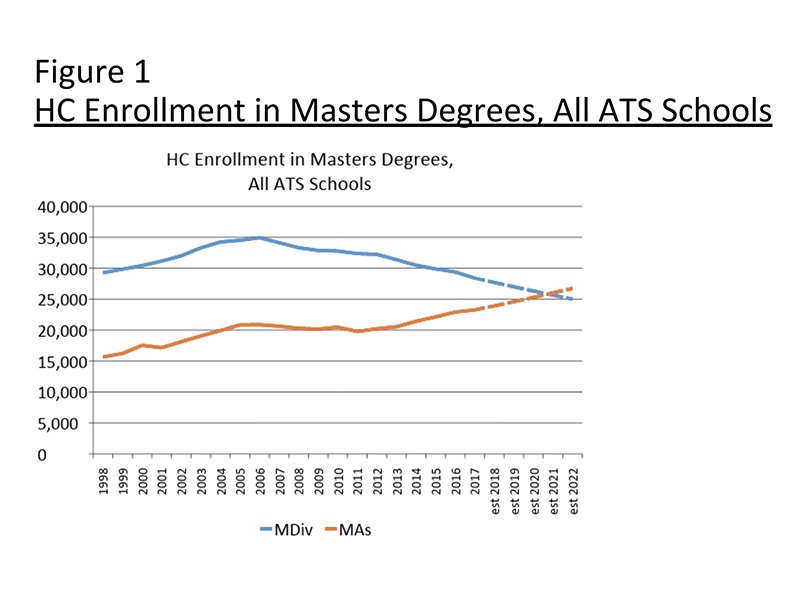
YONAT SHIMRON, of Religion News Service, reports on why more people looking to be ministers are favouring a Master of Arts over a Master of Divinity at US seminaries…
Like many seminary students walking across the stage to accept their diplomas at commencement ceremonies this month, Sean Robinson already has a job lined up.
Beginning in June, he will be the new minister to students and their families at Open Door Church in Raleigh, North Carolina.
But Mr Robinson’s diploma isn’t the traditional Master of Divinity, awarded to seminary students who have completed a three-year course of study.
He’s graduating with a master’s degree in ministry and leadership. And increasingly many other seminary students are, too.

Sean Robinson, left, stands next to professor Stephen Eccher at the commencement ceremony at Southeastern Baptist Theological Seminary in May, 2017. Mr Robinson graduated 11th May, 2018, with another master’s degree. PICTURE: Courtesy Sean Robinson
The gold standard for church leaders – the Master of Divinity – is losing some of its luster to its humbler cousin, the two-year Master of Arts.
“People are trying to get the training they need and get out,” said Mr Robinson, 28, who graduated on 11th May from Southeastern Baptist Theological Seminary in Wake Forest, North Carolina. “It all boils down to time and convenience and the culture and lifestyle we see today.”
“People are trying to get the training they need and get out. It all boils down to time and convenience and the culture and lifestyle we see today.”
– Sean Robinson, 28, who graduated on 11th May from Southeastern Baptist Theological Seminary in Wake Forest, North Carolina.
A new projection from the Association of Theological Schools, the main accrediting body for seminaries in the US and Canada, finds that the number of seminary students enrolled in various Master of Arts degrees will likely exceed the number of Master of Divinity students by 2021.
There were 28,400 students enrolled in the Master of Divinity degree last year, a gradual decline from a high of 35,000 in 2006. By comparison, there were 23,300 students enrolled in seminary Master of Arts programs last year, up from 20,800 in 2006.
The reasons for the decline in the Cadillac degree, required by most mainline denominations as well as the Catholic Church for anyone wanting to serve as pastor or associate pastor, are many and multifaceted.
One is the growth of seminaries affiliated with evangelical and Pentecostal denominations. These religious groups don’t typically require the Master of Divinity for men and women who want to be ordained.
Over the past 50 years, the share of Americans who identify with mainline Protestants, on the other hand, has been shrinking significantly as younger millennials leave the church and the ranks of the unaffiliated grows.
Some seminaries have responded by trimming the Master of Divinity credit hours from 90 to as low as 72 to be more competitive with the shorter MA degrees, while still keeping it a three-year degree.
It hasn’t worked.
“There’s no indication that reducing Master of Divinity credit hours leads to increased enrollment,” said Chris Meinzer, senior director of administration and chief financial officer at ATS.

Head count enrollment in master’s degrees, at ATS accredited seminaries. GRAPHIC: Courtesy of Chris Meinzer
Instead, the economics of church decline and practicalities of today’s students may play bigger roles.
Attending school full-time for three years and incurring loan obligations may contribute to some students’ calculations.
“The crisis we have is that if you’re graduating with a Master of Divinity you’re likely graduating with some significant debt and then you’ll struggle to find jobs and jobs that pay really low wages,” said Cameron Trimble, CEO of the Center for Progressive Renewal, which trains Christian leaders and helps older churches grow.
“The crisis we have is that if you’re graduating with a Master of Divinity you’re likely graduating with some significant debt and then you’ll struggle to find jobs and jobs that pay really low wages.”
– Cameron Trimble, CEO of the Center for Progressive Renewal.
Of course, attending seminary is far cheaper than law or medical school. Half of seminary students incur no debt when they graduate, and the average debt is $US36,000, according to the ATS, which accredits 270 theological schools.
But unlike previous generations in which students graduated from college and went straight to seminary, many of today’s students have already worked in some church capacity, meaning that congregations have already cracked open the door to their future employment. Completing a degree may be more a matter of earning ongoing professional training.
Mr Robinson, for example, started out as a Master of Divinity student but he switched to the MA track because he thought he might have an opportunity to plant a church in San Diego and wanted to complete his studies early. When that didn’t pan out, he found a full-time job at his seminary as an admissions counselor while taking classes for his master’s degrees as a part-time student.
“I felt like, with what I was receiving in the MA, it was no different from what was being offered in the MDiv,” he said.
Increasingly, some denominations feel that way, too.
The United Church of Christ, a liberal denomination, has traditionally required a Master of Divinity degree for anyone seeking to be ordained as a pastor. But in 2005, it adopted a “multiple pathways resolution” that allowed exceptions to the rule. The idea was to better respond to the needs of African-American, Native American and other minority congregations.
More recently, exceptions have been granted to men and women serving largely white communities, said John Dorhauer, president of the denomination.
Rev Dorhauer said the denomination has developed a tool for assessing who has the right mix of skills to be a minister in lieu of a Master of Divinity called the “Marks for Faithful and Effective Authorized Minsters.”
“Getting a Master of Divinity is no longer assurance, that, given how much is changing in the nature of church, that those who graduate with an MDiv are fully equipped to lead the churches that are emerging on the horizon,” he said.
Angie Arendt, a UCC minister in Almonte, Ontario, started out as a lay minister in a small church in Gilman, Iowa. She later took a job as a youth minister and small groups minister at a much larger UCC church in Des Moines, Iowa.
Though she took classes part-time at United Theological Seminary near Minneapolis, she never graduated but was ordained a minister.
“I’m really grateful for the time I had there, but I still had this amazing job in ministry that I loved,” she said. “For me to go to seminary made absolutely no sense. Why would I stop doing what they were training me to do?”
Other mainline denominations are also reassessing their pathways to ordination.
And many seminaries are realising their curricula may rely too heavily on the traditional academic subjects such as biblical studies, theology, Christian ethics, Hebrew and Greek, and that they lack a more intentional emphasis on leadership formation.
“We still believe the MDiv is an important degree.We recommend it as our primary track for students going into pastoral ministry or missions.”
– Bruce Ashford, Southeastern Baptist Theological Seminary.
Some are beginning to address that. As a first move, they are also allowing working students the opportunity to take classes online.
A few years ago, the ATS began allowing seminaries to offer online master’s degrees. It now allows seminaries – such as Southeastern Baptist – to offer an online Master of Divinity with no on-campus requirements. Nearly 30 seminaries – or about 10 per cent of the total – offer those online degrees.
It’s not clear if that option will lead more students to take up the Master of Divinity degree. Many of those online degrees are not necessarily cheaper.
At Southeastern’s commencement on 11th May, 97 graduates received their Master of Divinity degree and 87 were awarded MAs. While applications to the Master of Divinity program grew a modest six per cent over the past decade, the numbers of MA applications at Southeastern have exploded.
From 2008 to 2017, Southeastern more than doubled the number of MA students, said Bruce Ashford, the provost and dean of the faculty. Southeastern offers 16 different MA tracks – nine professional degrees and seven academic.
“We still believe the MDiv is an important degree,” Mr Ashford said. “We recommend it as our primary track for students going into pastoral ministry or missions.” But he acknowledged, “The MA is an attractive option for many.”





